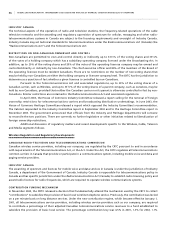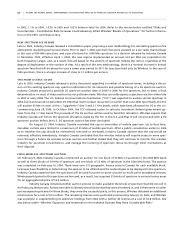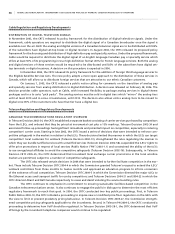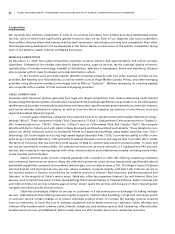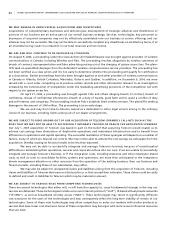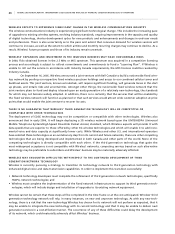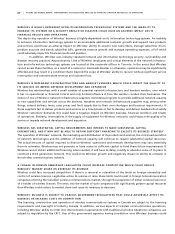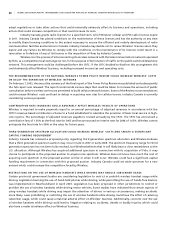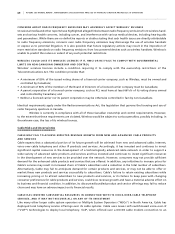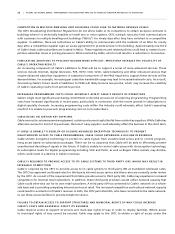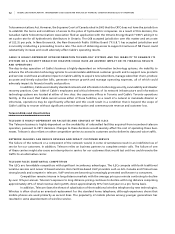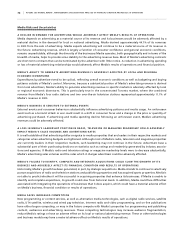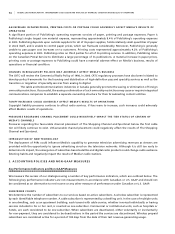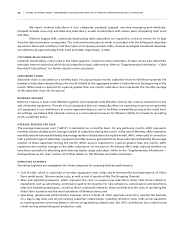Rogers 2005 Annual Report Download - page 70
Download and view the complete annual report
Please find page 70 of the 2005 Rogers annual report below. You can navigate through the pages in the report by either clicking on the pages listed below, or by using the keyword search tool below to find specific information within the annual report.
66 ROGERS 2005 ANNUAL REPORT . MANAGEMENT’S DISCUSSION AND ANALYSIS OF FINANCIAL CONDITION AND RESULTS OF OPERATIONS
WI R E LE S S E XP E C TS TO EX P E RI E NC E S I G NI F IC A NT C HA N GE IN T HE WI R ELE S S C OM M UNI C AT I ON S IN D US T RY
The wireless communications industry is experiencing significant technological change. This includes the increasing pace
of upgrades to existing wireless systems, evolving industry standards, ongoing improvements in the capacity and quality
of digital technology, shorter development cycles for new products and enhancements and changes in end-user needs
and preferences. There is also uncertainty as to the pace and extent that consumer demand for wireless services will
continue to increase, as well as the extent to which airtime and monthly recurring charges may continue to decline. As a
result, Wireless’ future prospects and those of its industry remain uncertain.
WI R E LE S S’ EX P A NS I ON AN D IN V ES T ME N T I N T H E I N UK S HU K BU S IN E SS MAY HA V E C ONS I DE R AB L E R I SK S
In 2000, Fido obtained licences in the 2.5 MHz or MCS spectrum. This spectrum was acquired in a competitive licensing
process and accordingly is subject to rollout commitments and commitments to fund a “Learning Plan”. If Wireless is
unable to roll out the service in accordance with Industry Canada requirements, the MCS licences could be revoked by
Industry Canada.
On September 16, 2005, Wireless announced a joint venture with Bell Canada to build a nationwide fixed wire-
less network by pooling our respective fixed wireless spectrum holdings and access to our combined cellular tower and
backhaul assets. This joint venture, known as Inukshuk, will require significant funding, will generate losses in the start
up phases, and entails risks and uncertainties. Amongst other things, the nationwide fixed wireless network that the
joint venture plans to fund and deploy is based upon an early generation of a relatively new technology, the standards
for which may not become widely adopted. In addition, there is no certainty that the services that will be enabled by
the fixed wireless network will function as planned or that such services would attract wide customer adoption at price
points that would enable the joint venture to recover its costs.
TH E R E I S N O G U AR A NT E E T H AT WI R EL E S S’ TH I RD G EN E RA T ION TE C HN O LOG Y W I LL BE C OM P ET I T IV E O R
CO M P AT I BL E W I T H O TH E R T E CH N OL O GI E S
The deployment of EDGE technology may not be competitive or compatible with other technologies. Wireless also
announced that in early 2006, it will begin deploying a 3G wireless network based upon the UMTS/HSDPA (Universal
Mobile Telephone System/High-Speed Downlink Packet Access) standard, which Wireless expects will provide it with
data speeds that are superior to those offered by other 3G wireless technologies and which will enable it to add incre-
mental voice and data capacity at significantly lower costs. While Wireless and other U.S. and international operators
have selected these technologies as an evolutionary step from its current and future networks, there are other competing
technologies that are being developed and implemented in both Canada and other parts of the world. None of the
competing technologies is directly compatible with each other. If the third generation technology that gains the
most widespread acceptance is not compatible with Wireless’ networks, competing services based on such alternative
technology may be preferable to subscribers and Wireless’ business may be materially adversely affected.
WI R E LE S S M AY E NC O UN T ER D IF F IC U LT I E S W IT H RE S PE C T T O T H E C ON T INU E D D EV E LOP M EN T O F TH I RD
GE N E RA T IO N N E T WO R K T EC H N OL O GY
Wireless is currently pursuing a strategy to transition its technology network to third generation technology with
enhanced digital voice and data transmission capabilities. In order to implement this transition successfully:
• Network technology developers must complete the refinement of third generation network technologies, specifically
HSDPA, network technologies; and
• Wireless must complete the implementation of the fixed network infrastructure to support its third generation tech-
nologies, which will include design and installation of upgrades to its existing network equipment.
Wireless cannot be certain that these steps will be completed in the time frame or at the cost anticipated. Wireless’ third
generation technology network will rely, in many instances, on new and unproven technology. As with any new tech-
nology, there is a risk that the new technology Wireless has chosen for its network will not perform as expected, that it
may be unable to integrate the new technology with its current technology and that it may be unable to deliver next
generation services in a cost-effective manner. The occurrence of any of these difficulties could delay the development
of its network, which could materially adversely affect Wireless’ business.


